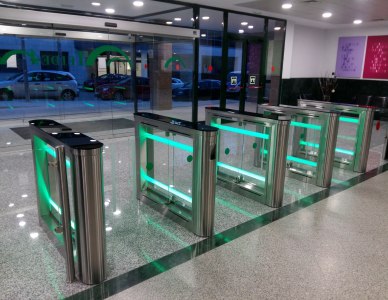When planning a high traffic security system project, special attention should be paid to the control and management system of access through area. Of all possible technical solutions, the use of turnstiles is often the most effective. Installation of our products is affordable, and the turnstile itself is practical and guarantees efficient control of personnel. Our units are multifunctional and efficient, whilst retaining a user friendly and welcoming interface between public & secure areas.
WHAT ARE THE TURNSTILES AND WHERE ARE THEY USED?
A turnstile is an electro-mechanical access barrier, it’s purpose is to protect secure areas from unauthorized access and, where necessary, to identify and log each person entering and exiting. The turnstile controls access, and at the same time can keep track of employees' times of attendance and cumulative working hours. There are several ways to control the turnstile: Manually – which will require an operator – i.e. a security guard or a receptionist; Automatically – automatic control is achieved by means of identification – i.e. access control proximity cards, keypads or RFID tags. Biometric access systems – innovative control technologies that identify the person using biometrics (fingerprint readers, retina scans, facial recognition devices, etc.). Turnstile functions can be varied. There are the basic models that only assist in orderly access through an entrance in business or leisure facilities, where a receptionist or security guard manually allows employees/visitors in after viewing their identity card. There are also quite complex and multifunctional solutions that identify an entering person by reading a card or biometric features; these can automatically enter the time of arrival and departure into a database, including providing automated accounting of the attendance patterns of employees or visitors.
APPLICATIONS OF TURNSTILES
Turnstiles are needed at premises where varying levels of security are required, especially where it is necessary to restrict, control and manage the access of all entering people. These can be: banks; hotels; airports; railway and bus stations; stadiums; leisure centres; shopping centres; industrial/manufacturing premises; business/enterprise centres; office buildings. Turnstiles provide controlled access for personnel and legitimate visitors, and restrict unauthorized access into secure premises or sensitive/restricted areas therein.
TYPES OF TURNSTILE
Various types of turnstiles can be implemented depending on the purpose of the premises where access control is required, and the needs of its facilitator. In premises with a large volume of people, such as sports stadiums or a transport hubs, the control of the space will require a completely different style of turnstile than at a business facility. Modern turnstile design can accommodate the requirements of a multitude of different premises.
TRIPODS The tripod turnstiles have three rotating arms (steel bars). They are the simplest but most popular type of turnstile, due to the following design features: Compact size – the ability to install multiple units in a limited space, for example in narrow corridors. Durability – reliable in operation, resistant to mechanical damage and can be used in applications with high traffic flow. Servo operation – a mechanism which automatically rotates the hub to allow access and returns to its original position at the end of the cycle. Fire/Panic system-- our units are equipped with an automated “anti-panic” system which drops the blocking arm and fully opens the lane for free passage. Bespoke units to match décor themes. IP65 protected units for outdoor use. In addition to the standard models there are specialised units – for installation in public transport hubs as well as for integration with ticket-access systems. SWING GATES Swing gates are more often used as auxiliary access control mechanisms and have the following features: On receipt of a dedicated signal the gate will open automatically and remain in the open position allowing several users to pass through at once. These gates are not equipped with presence sensors, therefore they do not react to a user in the passageway and safety is achieved by limitation of the static entrapment force of the blade. Swing Gates can have blades of over 1200 mm wide and serve as an emergency exit in case of alarm, with the added benefit of allowing access for trolleys and the transport of bulky items. The swing gate turnstiles can be used as the main access passage when operated in manual mode and controlled by a security operator/receptionist using the control panel or a radio remote.
FULL HEIGHT TURNSTILES Full-height turnstiles are the most common type of turnstiles for premises where total entrance protection is required. Such turnstiles cannot be jumped over or squeezed through. The rotor of full height turnstiles can be X-type (90 degrees) or Y-type (120 degrees). Full height turnstiles can be integrated with any type of access control system.
THE SPEED GATES TURNSTILES The swing turnstiles are highly reliable and stylish, with features including: Aesthetically pleasing contemporary styling, manufactured from stainless steel, polycarbonate and impact-resistant glass. An impressive and effective three-color change backlight system as standard. Optical safety sensors which prevent unauthorized multiple passage. Fast and efficient gate opening/closing speeds. These units will effectively cope in high traffic flow areas and at the same time harmoniously fit into the design of the premises. All types of turnstiles are available from Promex FP LLP. Our units are supplied to customers as a complete assembly, ready for simple installation, commissioning and operation.
 +7(727) 266-56-23
+7(727) 266-56-23 info@promex-world.com
info@promex-world.com
